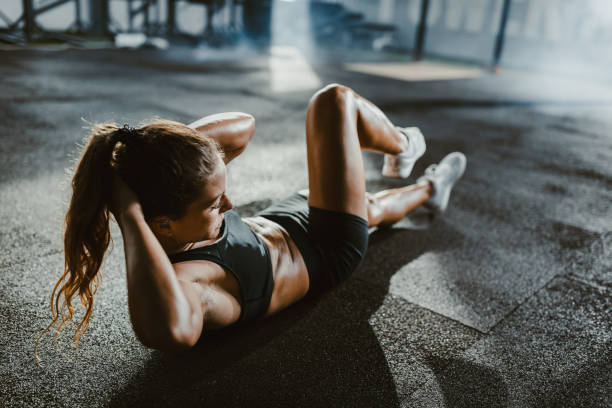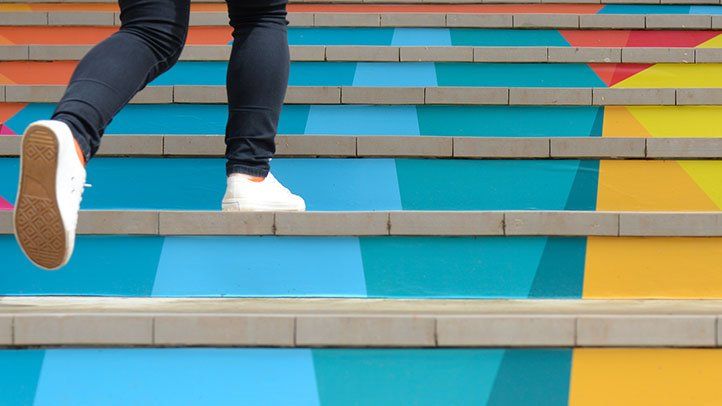How to get 6-pack abs and why it’s so difficult
Six-pack abs are often regarded as the pinnacle of fitness. If your middle is showing those segments, then you must be fit. Wrong.
It takes a lot of strength training to build your abdominal muscles. But before understanding the anatomy of sculpting a six-pack, you must first understand basic anatomy. First, Melody Scharff is a certified personal trainer. She is also an instructor at Fhitting Room which offers high-intensity interval Training (HIIT).
Your rectus abdominis is what looks like six abdominals, says Michele Olson. She is a senior clinical professor in sport science at Huntingdon College, Montgomery, Alabama. Dr. Olson explains that the rectus abdominal muscle has a large tendon running from right to left. These bands are actually on top of the rectus abdominals. “When the body fat is reduced, and the muscles of the rectus abdomens are developed, you can see the muscle between each dentation,” she explained.
What are the steps to get 6-Pack Abs?
To give your core a more defined look, you will need to strengthen your rectus abdominis. Scharff says that crunches will not get the job done.
These are the best abdominal strengtheners.
Scharff recommends performing advanced supine exercises (on your back), like jackknives, rotational (circular), movements like oblique medication ball slams, and suspended (from an elevated position), activities like knee tucks or L-sits.
- Jackknives: Lie on your back on the ground on your stomach. Reach your right hand towards your left toes and then sit up. Alternate your arms and legs.
- Oblique Medicine Ball Slams Standing, place a medicine ball on one hip and lift it overhead. Then, pivot your body to lower the medicine ball to the ground on the opposite side. Continue to alternate sides.
- Hanging Knee Tucks: Hold a bar and raise your arms high overhead. Tuck your knees to your chest.
- Hanging L-Sits: While holding onto a bar, with your arms raised, lift your legs straight up in front of your hips. This will create an L-shaped shape with your body.
Scharff suggests you do three rounds of each exercise for between 30 and 45 seconds per round.
You may also find other suspended movements beneficial. Research published in February 2017 in the Journal of Human Kinetics showed that the most effective way to activate the rectus abdominis was to use a TRX suspension trainer. This allows you to stand at an incline while keeping your arms parallel to the ground. Then, flex your shoulders and move your hands forward using the TRX straps. The body saw (placing your feet in the TRX handle and forming a plank, or push-up, with your forearms touching the ground, then pushing your body forward) also activated the rectus abdominis.
Pilates- and Yoga-Inspired Core Activities
You can also benefit from yoga-inspired Pilates moves. Olson says that Pilates exercises are suitable for all abdominal muscles. However, I found in lab testing that the roll-ups, teasers, and roll-over were very positive on the rectus abdominis. Olson explains how to make each of these moves.
- Roll-up Lie on your back flat on the ground, your legs straightening and your arms extended behind you. Your low back should not arch. Roll up your spine and let your arms hang in the air as you breathe in. As you roll up your spine, exhale and press your ribs downward. Your arms and your body should be extended forward. As you return to the original position, breathe in.
- Teaser: Lie on the ground, your legs straightening and your arms extended behind you. Your low back should not arch. Breathe in, and lift your legs off the ground by extending your arms. Breathe in and let your ribs sink as you roll your legs and upper body off the bed. Your arms and legs should be lifted to a 45-degree angle. Keep your arms and legs parallel to your legs. As you slowly return to the original position, breath in.
- Roll over. Lie flat on your back, stomach, and arms at your sides. Lift your legs to 90 degrees. As your pelvis tilts backward, breathe in and reach your legs above your head. Your palms should be flat on the ground. Keep your feet and legs parallel to each other. Slowly exhale and move your legs to the 90-degree position. Place one vertebra on the floor at a time.
Olson says hip-ups are great for your abs. You lie down on your back, with your feet pointed toward the ceiling, and lift your hips off the floor using your lower abs.
Olson recommends that you include yoga-inspired planks in your workouts. They protect your spine and strengthen your abs. A study in Sports Biomechanics journal found that a long-lever posterior tilt plank is particularly effective in developing your rectus abdominis. This advanced version of a traditional plank has your forearms on the ground, your elbows closer to your head than in standard planks, and your glutes compressed to tilt your pelvis forward.
Olson says that abdominal exercises can be done five times per week if you want to see ab definition. She suggests doing an ab sequence consisting of five to six activities.
Aerobic Exercise is a Good Choice
It’s not only about strengthening your core muscles. Olson says that HIIT and cardio training are the best options for anyone looking to shed the excess fat tissue below the muscle. It must be intense. You want to push your heart rate up to 85 percent of its maximum. After you have completed 20 minutes of hard cardio, like running and spinning, do this. Next, do 10 to 15 minutes of HIIT.
Are There 6-Pack Abs for Everyone?
The short answer is: Unfortunately, no. Scharff says visible abs are difficult for people who aren’t genetically blessed. Everybody’s muscles are different. Deeper muscle bellies create higher peaking between the tendons, making abs more visible. Some people have deeper muscle bellies than others, so that you might get different peaks or valleys than some people.
Your abs are affected by the size and shape of your tendons and your muscle fibers. These things can’t be changed. Olson says that some people have faster-twitch muscle fibers, which can be used to perform powerful bursts. Others have slower-twitch fibers, which aid in endurance tasks. Your abs will not develop as well if you have more slow-twitch muscle fibers than those with more fast-twitch fibers.
There’s also the issue of body fat. Scharff says that you can’t change a bad diet. Olson says, “You must cut out processed food and decrease overall calories to lose body fat. In addition, you need to eat enough protein, carbohydrates, and fats from fresh foods and lean meats. Even then, Olson states, “while it may be possible to see your abs, most of us are not realistic to have such clearly ripped abs as bodybuilders.”
Scharff explains that healthy body fat levels range from 15-20 percent for men and 20-25 percent for women. She says most people must lose about 10 percent to achieve visible six-packs. These numbers are achievable but only sustainable for some people’s lives. She adds that there is no way to guarantee your belly is losing fat.
Is a 6-Pack a sign that you’re fit?
A six-pack is nice. It’s not the only way to be fit. Olson explains that the rectus abdominals are only one of four abdominal muscles and one of eight core muscles. “Stability and stamina from your hips up to your shoulder blades is a strong core.” Professional athletes are not the only ones with a flat stomach or toned abdominal muscles.
You don’t need proof to prove you have a six-pack. Scharff says, “You might very well have a six-pack. It just might be concealed by a layer of fat.” Scharff suggests, ” Maybe you carry a lot of weight in your stomach.” She explains that being unable to see the muscles doesn’t negate their power.
A six-pack can be a bad idea, even if you are trying to look good. Scharff says that six-packs can signal that your body fat percentage is meager, but it could also mean sacrificing nutrition and not getting the best out of your training sessions.
Remember that what your muscles can do is more important than what they look like. Focus on building your muscles to do what you love, not how they look in the mirror.


